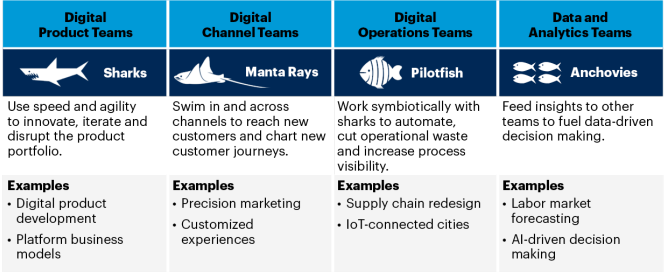
Organizations are reimagining the way they operate to enhance their digital business. As per Gartner, at least 84% of companies and 59% of government entities have set up “fusion teams.”
What are Fusion Teams?
Gartner defines a fusion team as a multidisciplinary team that blends technology or analytics and business-domain expertise and shares accountability for business and technology outcomes. Instead of organizing work by functions or technologies, fusion teams are typically organized by the cross-cutting business capabilities, business outcomes, or customer outcomes they support.
The growing prevalence of fusion teams signals the blurring of boundaries between IT and the rest of the business, and that too at an accelerated rate. A majority of fusion teams are agile and herald a new form of organization and value delivery. The work is organized in terms of cross-cutting business capabilities, business outcomes, and customer success instead of functions or responsibilities. In an ideal fusion team, members have a shared set of business objectives and are primarily driven by customer success and not the functional area that matches their expertise.
Such teams are replacing traditional, IT-centric delivery models and blending technology and other types of domain expertise. Fusion teams differentiate themselves from traditional interdependent teams in one major way: they defy the trend of cross-departmental teams not deploying the projects they work on. Since they have all of the talent required to develop a working, viable product, they deploy their products. This new digital delivery model enables CIOs and IT leaders to focus on the human side of managing digital business risk – the cultural, organizational, and behavioral aspects of risk management.
Here are a few use cases of fusion teams:
- Digital product teams deliver and maintain customer-facing digital products and services.
- Digital channel teams focus on the customer experience and seek to digitize and/or integrate marketing, sales, service, mobile and online channels.
- Digital operations teams capture benefits by further digitizing operations to automate, cut operational waste or increase process visibility.
- Data and analytics teams — perhaps the most common type of fusion team — provide insights that are consumed by other fusion teams to fuel data-driven decision-making.
Distributed Fusion Teams

What does the blurring of boundaries between IT and the rest of the business mean for organizations?
The rise of fusion teams in enterprises’ operating models has resulted in new dynamics between business units and IT teams. Business leaders are showing a lot of intent for planning, running, and managing their own digital initiatives.
As per Gartner’s survey:
- Around 40% of fusion team leaders work independently of IT (building applications using no-code platforms), but a majority of them involve IT in one way or another.
- 44% of such teams are led by someone from a function outside of IT. Even for organizations subject to multiple regulations with heavy data and security implications, nearly 40% of fusion teams report to a non-IT function.
However, the equation between fusion team leaders and IT (whether they are dependent on it or not) doesn’t play much of a role in deciding whether organizations achieve their business outcomes or fail to tackle the risks. Furthermore, none of the personal traits of fusion team leaders impact business outcomes. This includes the fusion team leader’s age, experience in the IT function, and level of seniority in the organization.
What makes a fusion team?
The fusion team includes a mix of individuals from different expertise. Note that a fusion team may or may not include a member from outside of an organization. For example, a Fusion team will have members from:
- Marketing
- Finance
- IT
- Operations
- Manufacturing
- End-user
So, what differentiates successful fusion team leaders from others?
Seasoned fusion team leaders have a sound “digital judgment” — a set of beliefs, mindsets, and behaviors that enables them to effectively align their team outcomes with enterprise outcomes. They own the risks of their technology decisions like adopting no-code platforms or depending heavily on IT teams throughout the software lifecycle. CIOs play an important role when it comes to improving digital judgment by providing access to IT governance subject matter experts who help fusion team leaders comprehend the implications of their technology decisions.
As per a Gartner fusion, team leaders with low levels of digital judgment, and team leaders with high digital judgment are 5.1 times more likely to deliver their team outcomes without exposing the enterprise to additional risks. Unfortunately, only 22% of fusion team leaders have high levels of digital judgment.

What are a few ideal traits of fusion team leaders?
1. Having a constructive mindset
They not only have the gumption to speak their mind but are also willing to go along with the established IT governance model to update standards and ways of working, to enhance their enterprise learning.
2. Not getting bogged down by the risks of digital business
They embrace security and risk management as part of their job, not just IT’s job.
3. Always willing to build for growth
They leverage proactiveness to help other teams — present and future — by managing the interdependencies between their own and others’ work.
What are the challenges with fusion teams?
The rise of fusion teams poses the risks of decentralized IT (or perhaps even shadow IT). Organizations that introduce new business models and digital initiatives through fusion teams face similar challenges:
1. Compliance and risk management being uneven
When the delivery environment is more diverse, distributed, and business-led, there is a high possibility of fusion teams lacking context to effectively balance team and enterprise outcomes. In such an environment, CIOs are often concerned that fusion team leaders will focus more on their team outcomes and might miss out on the broader enterprise’s concerns.
2. Digital talent management being subscale
Distributed talent acquisition and development practices are often subscales. Similarly, fusion teams risk creating new silos of expertise as companies struggle to capture economies of intellect and share lessons across domains.
3. Division of leadership responsibilities being unclear
The rise of fusion teams is linked with business leaders’ ambition to lead their own digital initiatives. But this ambition is often unevenly distributed between and within organizations. The new delivery model requires business units to take more business ownership than they are willing to take and a drastically different division of technology leadership responsibilities.
Overcoming the challenges
There are different ways to counter the risks associated with fusion teams. One school of thought believes that it is all about leadership—successful teams need great leaders to guide and motivate them. One school of thought emphasizes having star multidisciplinary T- or E-shaped profiles in the team more than leadership. Another school of thought encourages highly democratic models, where teams define their own objectives, roles, and responsibilities.
Some experts are of the opinion that teams should either rely on well-established processes and methodologies or emphasize the importance of co-location and collaboration. As per a Gartner survey of 500 cross-functional digitalization teams, employees work on overlapping tasks and activities, shuffle responsibilities, and learn from each other to develop new kinds of expertise. They are able to do so by relying on these four “fusion behaviors”:
1. Commitment towards coaching
Fusion team members are always willing to coach each other as they develop new areas of expertise. They value shared team outcomes and non-financial rewards for coaching others. Such incentives can positively impact fusion behaviors, particularly a commitment to coaching. But to the contrary, most fusion teams fail to promote and sometimes even hamper employees’ coaching intent because they do one or more of the following:
- Value individual goals and performances that create rifts among the team members – which goes against the very basis of coaching.
- Unable to educate or motivate employees regarding the coaching expectations.
- Put a lot of emphasis on financial rewards, which are insufficient to drive coaching behaviors.
To overcome the above-mentioned challenges, progressive IT organizations realign employee objectives and incentives to encourage coaching. They make employees realize that in a fusion team, success comes from enhancing others’ performance, not just one’s own.
2. Commitment toward a learning mindset
Fusion team members are always willing to collaborate and build expertise in new domains. A culture of learning instigates a sense of participation among the team members. It makes them more adaptable and agile and prepares them to gel even better within future fusion teams. The downside of this culture is that it often pushes employees to go beyond their traditional roles and responsibilities, which sometimes hamper their career growth. In fact, 82% of employees believe that working outside their function will slow their careers.
Organizations are trying to give a different meaning to career trajectories so that employees see fusion team assignments as learning opportunities that increase their employability. These new career trajectories link progression with the diversity of an employee’s experiences. A good way to communicate this shift is to show experience-based career maps to the employees. These maps focus on the path as much as the destination but do not show progress as a linear, largely vertical movement. Instead, they emphasize the importance of gaining diverse experiences through lateral and vertical moves that help build the necessary capabilities to take up a critical role in the future.
3. Commitment towards open disposition
Fusion team members are always open to risk, uncertainty, and new ways of working.
Employees who thrive in fusion teams must have an open mind that embraces risk, uncertainty, and novel ways of working. Regrettably, decades of standardization and centralization have turned 94 percent of IT employees into risk-averse, process-centric, or functional silo-oriented individuals.
To create an organization that is receptive to risks, uncertainties, and novel ways of working, IT leaders should concentrate on changing the IT climate or the shared employee perceptions of the IT organization. By altering the signals they send to employees regarding risk-taking and experimentation, leaders can directly impact the climate in information technology, which in turn shapes culture over time.
4. Commitment towards digital Acumen
Fusion teams are willing to understand how digitalization affects the wider business context and requires new ways of working.
Members of fusion teams must understand what digitalization entails for their organization and how to maximize its benefits. Regrettably, 56% of senior leaders admit to lacking this knowledge (figure 10). For more junior employees, the figure is even higher. To address this knowledge gap, progressive organizations have formalized digital acumen as a leadership competency and invest in its development through leadership development programmes. Such programmes foster enterprise digital readiness by cultivating a digital leadership that is aware of the magnitude of operational and other enterprise-wide changes necessary for digitalization success.
Conclusion
Due to the numerous interdependencies and stakeholders associated with broad-based digitalization, CIOs require flexible, cross-cutting fusion teams across their organizations. Fusion teams can weather the uncertainty and interconnectedness of digitization initiatives due to their ability to quickly learn from one another and develop new types of expertise. Fusion team members demonstrate a commitment to coaching one another, an ability to pick up new skills quickly, an open mind toward risks and uncertainties, and a high level of digital literacy. To assist their organizations in successfully transforming digitally, CIOs and other IT leaders must look beyond “unicorn” employee profiles and take practical steps to scale fusion teams.
Frequently Asked Questions( FAQ’s )
1. What exactly are fusion teams, and how do they work?
Fusion teams are interdisciplinary groups that combine business expertise with technology or analytics skills. They focus on achieving shared business outcomes, often bypassing traditional IT silos and collaborating across departments to deliver impactful results.
2. What role does no-code development play in fusion teams?
No-code platforms empower fusion teams by allowing them to build and deploy applications without needing extensive coding knowledge. This fosters agility, reduces dependency on IT, and speeds up digital projects, making it easier for teams to focus on business outcomes.
3. How do fusion teams break down traditional IT silos?
Fusion teams blur the lines between IT and business functions by creating cross-functional teams that share accountability for both business and technology outcomes. This approach fosters innovation, as teams work towards shared goals rather than being confined by traditional departmental roles.
4. How can no-code tools help fusion teams stay agile?
No-code tools allow fusion teams to create and modify applications quickly, which is essential in fast-paced environments. These platforms reduce the dependency on developers, streamline processes, and allow business users to contribute directly to application development, improving team agility.
5. What makes a good leader for a fusion team?
A good fusion team leader is someone who fosters collaboration, embraces risk, and can make well-informed digital decisions. They also understand the need for balancing business needs with technology solutions and guide their teams towards achieving collective goals.
Login
Please login to comment
0 Comments
Oldest
















